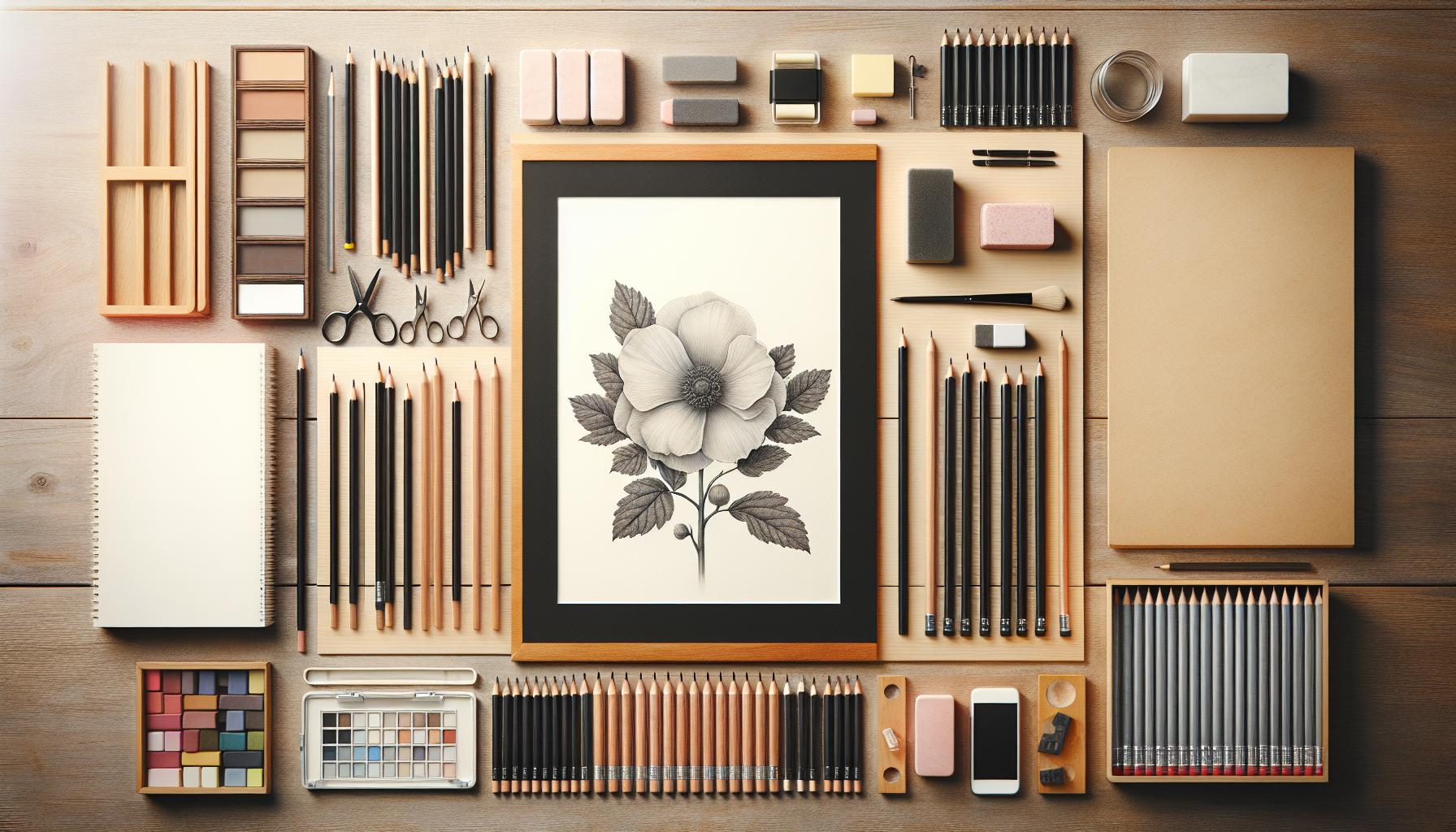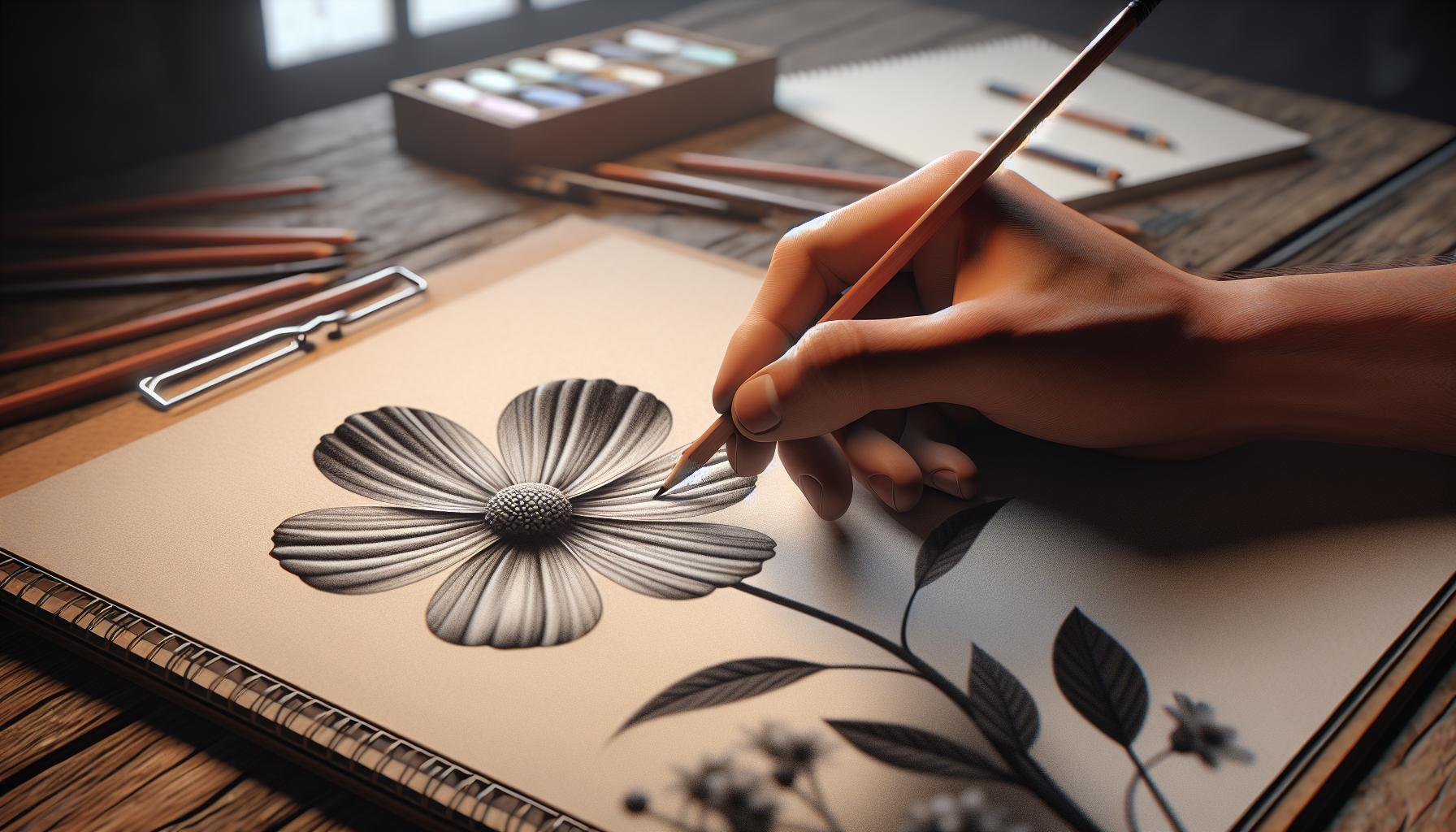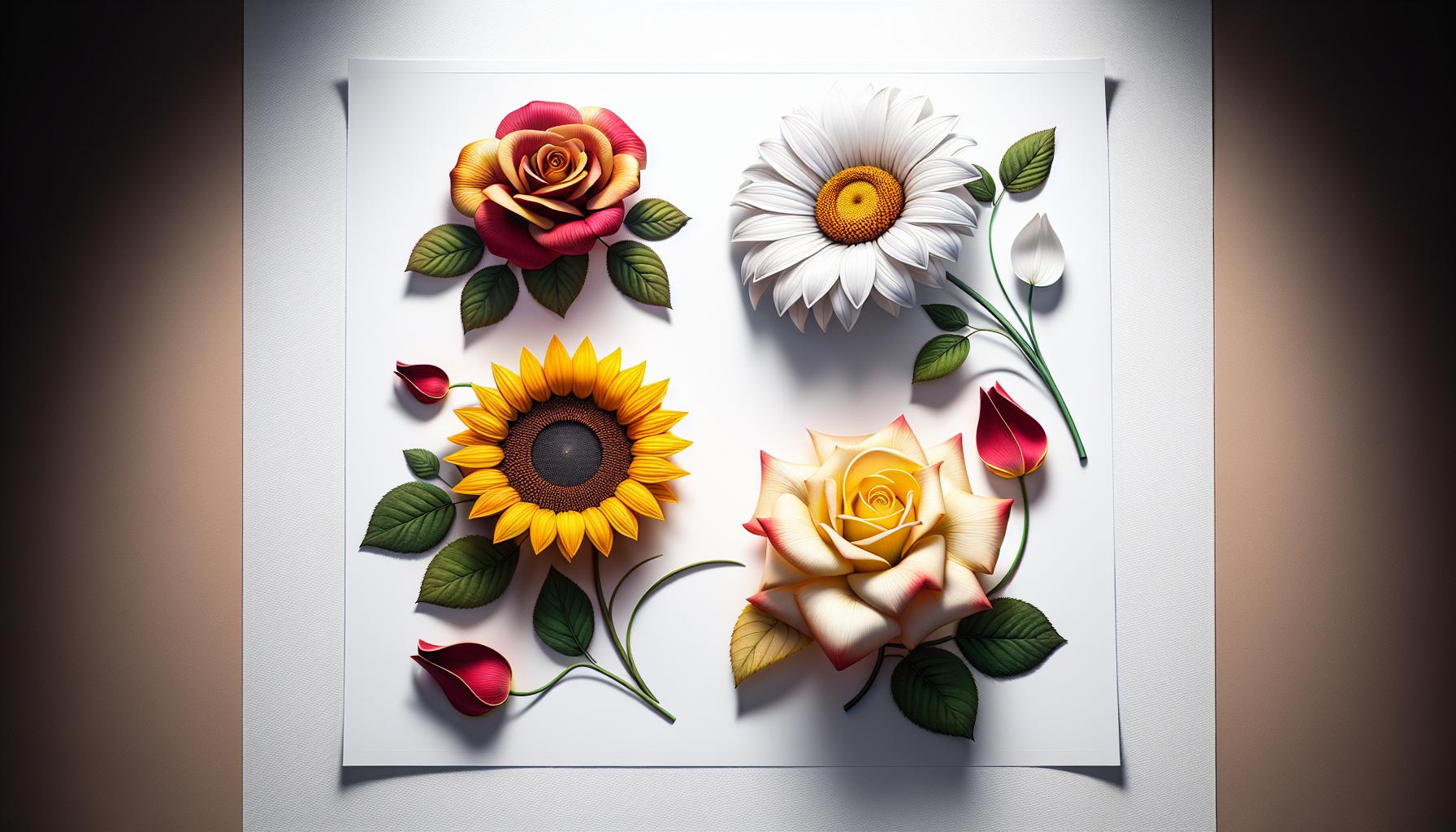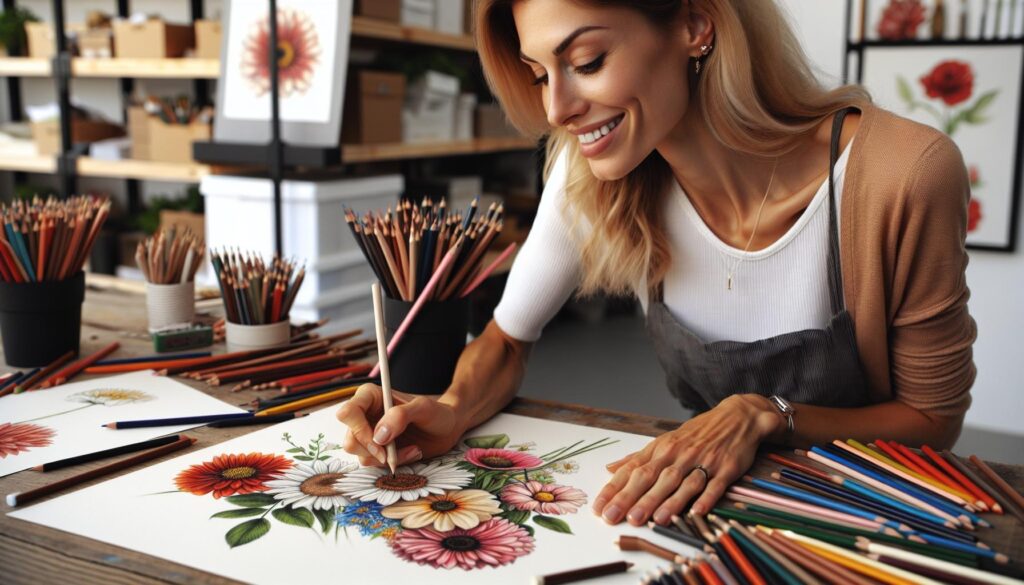Drawing flowers brings a touch of natural beauty to any artistic endeavor, and it’s easier than most people think. From simple daisies to elegant roses, flower sketches can transform a blank page into a blooming garden of creativity. Whether someone’s an aspiring artist or just looking for a relaxing hobby, learning to draw flowers offers a perfect starting point.
Artists and beginners alike discover that drawing flowers helps develop fundamental artistic skills while providing endless opportunities for personal expression. With just a few basic shapes and techniques, anyone can create stunning floral artwork. These timeless subjects have inspired countless generations of artists and continue to captivate viewers with their delicate forms and intricate details.
Facil:iiwd7u4dpig= Flores Dibujo
Basic Shapes Foundation
Starting with geometric shapes creates the foundation for flower drawings. Circles form flower centers while ovals create petals. Simple triangles evolve into leaves. Combining these shapes produces recognizable flower forms in 3-4 steps.
Line Work Essentials
Light pencil strokes establish initial outlines for flower elements. Curved lines create natural petal shapes. Single continuous lines form stems. Varying line thickness adds depth to petals edges.
Step-by-Step Methods
- Draw a center circle
- Add 5-8 evenly spaced petals
- Connect petal shapes to the center
- Sketch a straight stem
- Add leaves along the stem
Common Flower Types to Practice
- Daisies: 8-12 uniform petals around a circular center
- Tulips: 6 overlapping teardrop-shaped petals
- Sunflowers: Large center with numerous pointed petals
- Roses: Spiral pattern starting from center point
Essential Tools
| Tool | Purpose |
|---|---|
| HB Pencil | Initial sketching |
| 2B Pencil | Adding details |
| Eraser | Refining shapes |
| Drawing Paper | Smooth surface |
- Cross-hatching creates texture in flower centers
- Gradual pressure builds petal dimension
- Circular motions blend shadow areas
- Directional strokes follow petal curves
- Single direction shading defines leaves
These techniques form an artistic foundation for creating simple yet expressive flower drawings that capture natural botanical elements.
Essential Drawing Materials and Tools

Creating beautiful flower drawings requires a carefully selected set of materials that enable precise lines, subtle shading, and detailed textures.
Paper and Pencil Selection
High-quality drawing paper with a medium tooth texture provides the ideal surface for flower sketches. Bristol board (100 lb) offers smooth surfaces for detailed work, while cold-pressed watercolor paper (140 lb) creates textured effects. Drawing papers from brands like Strathmore or Canson deliver consistent results for graphite applications.
The optimal pencil grades for flower drawing include:
| Pencil Grade | Primary Use |
|---|---|
| 2H | Initial sketches |
| HB | Main outlines |
| 2B | Shading details |
| 4B | Dark values |
Basic Drawing Supplies
A complete flower drawing toolkit includes:
- Kneaded eraser for lifting graphite highlights
- White vinyl eraser for clean removal of lines
- Pencil sharpener with dual holes for precise points
- Blending stumps in 3 sizes (small, medium, large)
- Drawing board or clipboard for stable surface support
- Ruler for measuring proportions
- Protective sleeve for completed artwork
| Item Type | Recommended Storage |
|---|---|
| Pencils | Canvas roll-up case |
| Papers | Acid-free portfolio |
| Tools | Compartment box |
Simple Flower Drawing Steps

Creating beautiful flower drawings starts with mastering fundamental shapes and building layers of detail. This section breaks down the process into manageable steps that transform basic geometric forms into lifelike floral artwork.
Starting with Basic Shapes
Simple flower drawings begin with circles, triangles and ovals as foundational elements. A center circle forms the flower’s core, while 5-8 evenly spaced oval petals create the basic flower structure. Light pencil strokes establish the initial stem using a single straight line, accompanied by 2-3 leaves drawn as pointed ovals along its length. The flower head position determines the natural curve of the stem, bending slightly toward the light source. Essential measurements include:
| Element | Size Ratio |
|---|---|
| Center Circle | 1x |
| Petals | 2-3x center size |
| Stem Width | 1/4x center size |
| Leaves | 1.5x petal size |
- Central veins running length-wise
- Secondary veins branching at 45-degree angles
- Varied pressure creating light and dark areas
- Subtle curves following leaf contours
Popular Flowers to Draw

Certain flowers present ideal subjects for drawing practice due to their recognizable shapes and balanced structures. These popular choices offer varying levels of complexity while teaching essential drawing techniques.
Daisies and Sunflowers
Daisies feature simple geometric patterns with a round center surrounded by evenly spaced petals. The basic daisy structure consists of a yellow circle core with 8-12 white petals radiating outward. Sunflowers showcase a similar pattern on a larger scale, with a prominent spiral seed head pattern in the center disk surrounded by two layers of pointed yellow petals. The inner disk follows the Fibonacci sequence, creating natural spiral patterns that add visual interest. Both flowers incorporate straight stems with opposing leaves, making them excellent subjects for practicing symmetry and proportion.
Roses and Tulips
Roses demonstrate layered complexity through overlapping petals that spiral from a central point. Each rose petal curves gracefully outward, creating depth through gradual transitions from light to shadow. Tulips display simpler forms with 6 teardrop-shaped petals arranged in a cup formation. The petals feature subtle curves at their tips with distinctive creases running lengthwise. Both flowers exhibit unique stem characteristics – roses with thorns and curved foliage, tulips with long straight stems and lance-shaped leaves. These flowers teach essential shading techniques through their varied petal formations and natural gradients.
Shading and Coloring Methods
Shading and coloring transform basic flower drawings into vibrant, three-dimensional artwork. These techniques add depth, texture, and visual interest to floral illustrations through strategic application of values and hues.
Pencil Shading Techniques
Graphite shading creates depth and form in flower drawings through controlled pressure and mark-making methods. Cross-hatching builds shadows with intersecting lines at 45-degree angles, while circular strokes blend smoothly for rounded petals. Stippling adds texture through concentrated dots, dense in shadow areas and sparse in highlights. The pressure-gradient technique produces seamless transitions from light to dark values by gradually increasing pencil pressure. Artists achieve realistic petal textures by layering strokes in the direction of growth, starting light near petal tips and darkening toward the flower center. Burnishing with harder pencils smooths shaded areas, while lifting highlights with a kneaded eraser creates shine points.
Using Colors Effectively
Color application enhances flower drawings through strategic layering of pigments. Light colors establish base tones, while darker shades create depth in petal overlaps and shadows. Complementary colors, like purple with yellow or red with green, add vibrancy to flower compositions. Artists blend analogous colors, such as yellow-orange transitions in sunflower petals, for natural gradients. Cool colors recede while warm colors advance, creating dimensional effects in multi-flower arrangements. White highlights maintain petal luminosity, particularly in roses and lilies. Color intensity varies from saturated flower centers to softer petal edges, reflecting natural light behavior. Local color accuracy combines with shadow colors to achieve realistic flower representations.
Common Drawing Mistakes to Avoid
Drawing flowers requires attention to specific details to achieve realistic results. Here are critical errors to watch for when creating floral artwork:
- Improper Proportions
- Making flower centers too large compared to petals
- Drawing uneven petal sizes
- Creating stems thicker than the flower head
- Positioning leaves at unrealistic angles
- Inconsistent Light Source
- Placing shadows in multiple directions
- Adding highlights that conflict with the main light direction
- Missing core shadows on curved petals
- Ignoring reflected light on overlapping elements
- Rigid Line Work
- Drawing petals with straight mechanical lines
- Using uniform line weight throughout
- Creating hard edges for soft flower elements
- Outlining every detail instead of suggesting form
- Texture Mistakes
- Applying the same texture pattern across all petals
- Overdoing surface details
- Missing natural variations in petal surfaces
- Ignoring the directional flow of texture lines
- Color Application Errors
- Using pure black for shadows
- Applying flat single colors without variation
- Missing color temperature changes in shadows
- Ignoring color transitions between petals
- Composition Issues
- Centering every flower in the drawing
- Creating symmetrical arrangements
- Drawing flowers at identical angles
- Placing all elements on the same plane
These mistakes affect the natural appearance of floral drawings. Artists improve their work by focusing on organic shapes variations subtle color transitions natural textures.
Journey Into Artistic Expression
Drawing flowers offers a delightful journey into artistic expression that’s accessible to everyone. The combination of basic shapes careful observation and practiced techniques opens up endless possibilities for creating beautiful floral artwork.
Armed with the right tools and knowledge artists can transform simple geometric forms into stunning botanical illustrations. Whether sketching daisies roses or sunflowers each flower presents unique opportunities to develop essential drawing skills.
The art of flower drawing continues to captivate both beginners and experienced artists providing a timeless medium for creativity and artistic growth. Through dedicated practice and attention to detail anyone can master the art of bringing flowers to life on paper.

